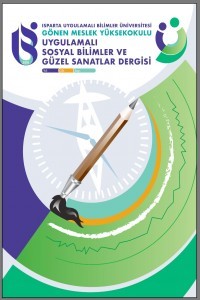AKDENİZ BÖLGESİ İLLERİ KAPSAMINDA YÜKSEKÖĞRETİM VE REEL GELİR DEĞİŞKENLERİNİN PANEL NEDENSELLİK ANALİZİ
Bu çalışma Akdeniz Bölgesi’ni oluşturan Adana, Antalya, Burdur, Hatay, Isparta, Mersin, Kahramanmaraş ve Osmaniye’ye ait 2008-2017 dönemi yükseköğretim öğrenci ve akademisyen sayıları ile reel gelir serileri arasındaki nedensel ilişkileri araştırmayı amaçlamaktadır. Pedroni (1999, 2004) eşbütünleşme testi sonuçları değişkenlerin eşbütünleşik olduğuna işaret etmiştir. Ardından Dumitrescu ve Hurlin (2012) nedensellik testi uygulanmış ve reel gelirden hem yükseköğretimdeki öğrenci sayısına hem de akademisyen sayısına tek yönlü nedensellikler tespit edilmiştir. Ayrıca akademisyen sayısından yükseköğretim öğrenci sayısına yönelik tek yönlü bir nedensellik mevcuttur. Buna karşın diğer yönlerde herhangi bir nedensellik gözlenememiştir.
Anahtar Kelimeler:
Bilgi, Eğitim, Beşerî Sermaye, Gelir, Panel Nedensellik
___
- Afşar, M. (2009). “Türkiye’de eğitim yatırımları ve ekonomik büyüme ilişkisi”, Anadolu Üniversitesi Sosyal Bilimler Dergisi, 9(1), 85-97.
- Akçacı, T. (2013). “Eğitim harcamalarının iktisadi büyümeye etkisi”, Kafkas Üniversitesi İktisadi ve İdari Bilimler Fakültesi Dergisi, 4(5), 65-79.
- Boutayeba, F., ve Ramli, M. (2019). “The Link Between Education And Economic Growth In Algeria: An Empirical Investigation”, International Journal of Advanced Research in Education and Society, 1(1), 35-43.
- Chaudhary, A. R., Iqbal, A. ve Gillani, S. Y. M. (2009). “The nexus between higher education and economic growth: An empirical investigation for Pakistan”, Pakistan Journal of Commerce and Social Sciences (PJCSS), 3, 1-9.
- Choi, I. (2001).” Unit root tests for panel data”, Journal of international money and Finance, 20(2), 249-272.
- Dahal, M. P. (2010). “Higher educational enrollment, school teachers and GDP in Nepal: A causality analysis”, Economic Journal of Development Issues, 69-91.
- Dănăcică, D. E., Belașcu, L.ve Ilie, L. (2010). “The interactive causality between higher education and economic growth in Romania”, International Review of Business Research Papers, 6(4), 491-500.
- De Meulemeester, J. L., ve Rochat, D. (1995). “A causality analysis of the link between higher education and economic development”, Economics of Education Review, 14(4), 351-361.
- Dumitrescu, E. I., ve Hurlin, C. (2012). “Testing for Granger non-causality in heterogeneous panels”, Economic modelling, 29(4), 1450-1460.
- Dünya Bankası (2019). Dünya Gelişmişlik Göstergeleri, https://databank.worldbank.org/reports.aspx?source=world-development-indicators (Erişim Tarihi: 12.08.2019).
- Hussin, M. Y. M., Muhammad, F., Hussin, M. F. A., ve Razak, A. A. (2012). “Education expenditure and economic growth: a causal analysis for Malaysia”, Journal of Economics and Sustainable Development, 3(7), 71-81.
- Im, K. S., Pesaran, M. H., ve Shin, Y. (2003). “Testing for unit roots in heterogeneous panels”, Journal of econometrics, 115(1), 53-74.
- Islam, T. S., Wadud, M. A., ve Islam, Q. B. T. (2007). “Relationship between education and GDP growth: A multivariate causality analysis for Bangladesh”, Economics Bulletin, 3(35), 1-7.
- Levin, A., Lin, C. F., ve Chu, C. S. J. (2002). “Unit root tests in panel data: asymptotic and finite-sample properties”, Journal of econometrics, 108(1), 1-24.
- Lucas Jr, R. E. (1988). “On the mechanics of economic development”, Journal of monetary economics, 22(1), 3-42.
- Mekdad, Y., Dahmani, A., ve Louaj, M. (2014). “Public spending on education and economic growth in Algeria: Causality test”, International Journal of Business and Management, 2(3), 55.
- Özsoy, C. (2009). “Türkiye’de eğitim ve iktisadi büyüme arasındaki ilişkinin VAR modeli ile analizi”, Bilgi Ekonomisi ve Yönetimi Dergisi, 4(1), 71-83.
- Pamuk, M., ve Bektaş, H. (2014). “Türkiye’de eğitim harcamaları ve ekonomik büyüme arasındaki ilişki: ARDL sınır testi yaklaşımı”, Siyaset, Ekonomi ve Yönetim Araştırmaları Dergisi, 2(2), 77-90.
- Pedroni, P. (1999). “Critical values for cointegration tests in heterogeneous panels with multiple regressors”, Oxford Bulletin of Economics and statistics, 61(S1), 653-670.
- Pedroni, P. (2004). “Panel cointegration: asymptotic and finite sample properties of pooled time series tests with an application to the PPP hypothesis”, Econometric theory, 20(3), 597-625.
- Rahman, M. M. (2011). “Causal relationship among education expenditure, health expenditure and GDP: a case study for Bangladesh”, International Journal of Economics and Finance, 3(3), 149-159.
- Şen, H., Kaya, A., ve Alpaslan, B. (2018). “Education, Health, and Economic Growth Nexus: A Bootstrap Panel Granger Causality Analysis for Developing Countries”, Sosyoekonomi, 26(36), 125-144.
- TÜİK (2019). İstatistik Göstergeler, https://biruni.tuik.gov.tr/ilgosterge/?locale=tr (Erişim Tarihi: 12.08.2019).
- Yaylalı, M., ve Lebe, F. (2011). “Beşeri sermaye ile iktisadi büyüme arasındaki ilişkinin ampirik analizi”, Marmara University Journal of the Faculty of Economic & Administrative Sciences, 30(1), 23-51.
- YÖK (2019). Yükseköğretim Bilgi Yönetimi Sistemi, https://istatistik.yok.gov.tr/ (Erişim Tarihi: 12.08.2019).
- Başlangıç: 2019
- Yayıncı: Isparta Uygulamalı Bilimler Üniversitesi
Sayıdaki Diğer Makaleler
DANI CALIFORNIA VİDEO KLİBİ’NİN ÇOK SESLİ YAPISINA GÖSTERGELERARASI BİR BAKIŞ
Ece ÇALIŞ ZEĞEREK, Ali M. BAYRAKTAROĞLU
HASTANELERDEKİ TIBBİ DOKÜMANLARIN GELENEKSEL ORTAMDAN ELEKTRONİK ORTAMA DÖNÜŞÜMÜ
TÜRKİYE’DE YAĞ GÜLÜNÜN SON ON YILDAKİ EKONOMİK GELİŞİMİ VE SEKTÖRE İLİŞKİN MEVCUT SORUNLARIN ANALİZİ
